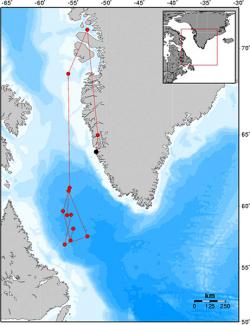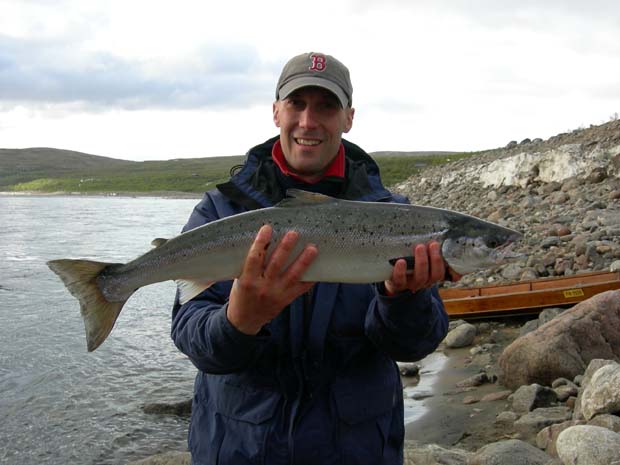NOAA / July 15, 2013
Research conducted by NOAA scientists at the Northeast Fisheries Science Center is turning the spotlight on the ocean and its importance to the recovery and management of Atlantic salmon

Greenlandic fishermen tending his gillnet. Gillnets are set close to shore, often one end is secured to the shore, and target Atlantic salmon feeding on abundant resources of capelin and squid along the west coast of Greenland. Photo by Kai Benson for Castletown Productions.
[dropcap]T[/dropcap]here is a reason why only farmed Atlantic salmon is available to U.S. consumers. Wild Atlantic salmon, once abundant in the Northeastern United States, has been in trouble for decades due to multiple factors, including habitat loss, historic overfishing and varying ocean conditions. To date, the only remnant populations of Atlantic salmon can be found in Maine and are listed as endangered under the Endangered Species Act. Atlantic Salmon are anadromous fish, which means they hatch in freshwater streams but spend about half of their life in the open ocean, later returning to freshwater to spawn. With the construction of hundreds of dams along the Northeast coast beginning in the late 1800s, salmon populations began to decline dramatically. Dams create a physical barrier preventing free access for fish swimming back to their natal streams to reproduce.
But there is good reason for hope. In the United States, progress is being made to recover wild Atlantic salmon populations. Commercial fishing has been prohibited and substantial efforts are being made to recover critical salmon habitat and improve fish passage by altering or removing dams. One of the major dam removal and habitat restoration projects NOAA Fisheries has been involved in is the Penobscot River Restoration Project Exit, the largest dam removal protect in the Northeast. Eliminating two dams and bypassing a third will improve access to nearly 1000 miles of river on the Penobscot River, a critical salmon habitat area.
What is happening at sea?

Re-constructed migration route of an Atlantic salmon tagged and released with a pop-off satellite tag off the coast of West Greenland during September 2011. The tag popped-off on the pre-programmed pop-off date of April 1, 2012, hence the fish was at large for 7 months. Map created using the Maptool program, a product of SEATURTLE.ORG.
Salmon spend a good portion of their lives in the open ocean, swimming beyond national boundaries, so international collaboration is critical to the recovery of the species. “We have learned a lot about what happens to salmon in the freshwater environment, but we still have a way to go to fully understand the impacts of the marine environment on the species,” said Tim Sheehan, NOAA scientist at the Northeast Fisheries Science Center. “The ocean has always been a big unknown for salmon, but research that we and our international colleagues have been involved in is shedding light into how important the marine ecosystem is and what factors may impact salmon during their time at sea.”
NOAA Fisheries has been involved in multiple research protects with other countries, such as Canada Greenland, Ireland, Norway and the United Kingdom to gain a better understanding of where salmon are going and what is happening to them once they leave freshwater. “Some of the results we are seeing with these studies are remarkable. Research is showing that environmental factors, such as ocean temperature and food web changes, are dramatically influencing abundance and productivity of North American salmon populations,” said Sheehan. “What happens at home in rivers is only half of the picture. We need to better understand and take into account the marine environment as well. The scope of this challenge is huge; no country can answer the questions facing wild Atlantic salmon alone.”
On the international front, the United States has worked hard to establish conservation measures for Atlantic salmon that are as strong outside its Exclusive Economic Zone as inside. The United States is a member of the North Atlantic Salmon Conservation Organization (NASCO) Exit, the international fisheries organization responsible for Atlantic salmon management and conservation. NASCO has played a key role in eliminating broad scale commercial Atlantic salmon fisheries internationally in key marine habitat areas off of West Greenland and Faroe Islands. West Greenland is particularly important to U.S. salmon populations as this is where they go, together with Canadian and European origin salmon, to eat, grow and mature before making the long trek home to spawn. In addition to management actions, the United States has also been a leader of numerous international research initiatives Exit in the Northwest Atlantic. This important work may provide valuable information related to a critical but understudied life stage of the species, which will support conservation and management efforts of wild Atlantic salmon across the North Atlantic.


